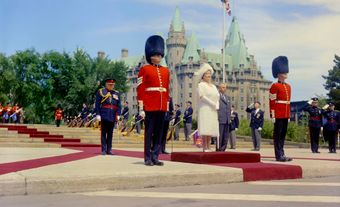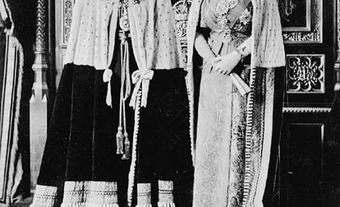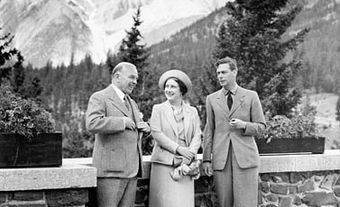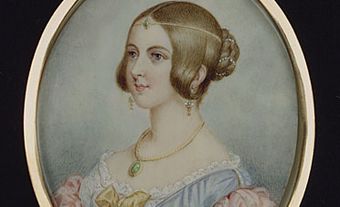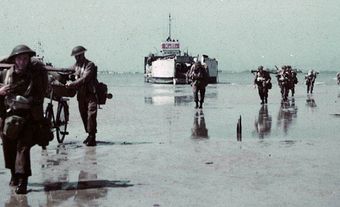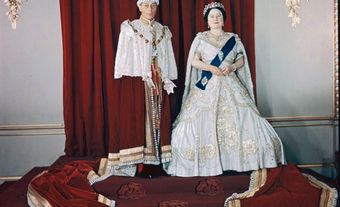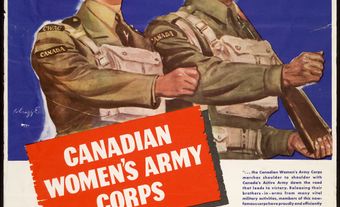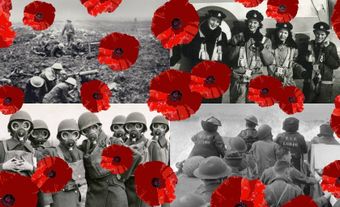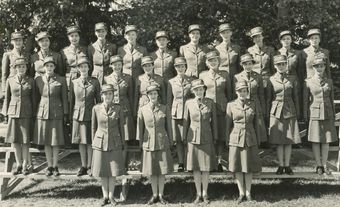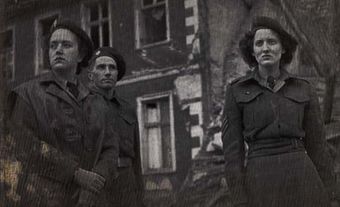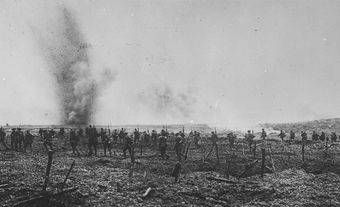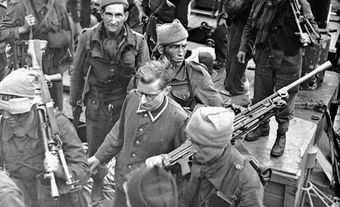Princess Victoria Alexandra Alice Mary, Countess of Harewood (HRH The Princess Royal) (born 25 April 1897 in Norfolk, United Kingdom; died 28 March 1965 in West Yorkshire, United Kingdom). Princess Mary was the third child and only daughter of King George V and Queen Mary, the younger sister of King Edward VIII and King George VI and the great-aunt of King Charles III. Mary was president of The Girl Guides Association (now known as Girlguiding) from 1920 to 1965. She was colonel-in-chief of The Canadian Scottish Regiment (Princess Mary’s), the Royal Canadian Corps of Signals and the Royal Newfoundland Regiment. She also represented her niece Queen Elizabeth II on three official tours of Canada in 1955, 1962 and 1964.

Early Life and Education
Princess Mary was born at York Cottage on the Sandringham Estate during the reign of her great-grandmother Queen Victoria. Her grandfather King Edward VII succeeded to the throne in 1901, and her parents became king and queen in 1910. Mary was educated at home by governesses and became fluent in French and German. She enjoyed outdoor pursuits and was an accomplished horsewoman.

Princess Mary’s Christmas Gift Fund
When the First World War began in 1914, Princess Mary was 17 years old. That year, she launched an appeal for donations to “help me to send a Christmas present from the whole of the nation to every sailor afloat and every soldier at the front.” She raised more than £150,000 — the equivalent of more than £14 million in 2024. More than 2.6 million brass boxes embossed with Mary’s portrait were sent to all those in “the King’s uniform,” including the Canadian Expeditionary Force. Most boxes contained cigarettes, tobacco, a pipe, a tinder lighter and a Christmas card; non-smokers, including Sikh troops, received sugar candy, a tin box of spices and a Christmas card, while nurses received chocolates.
Nursing
In 1917, Princess Mary became commandant of a Voluntary Aid Detachment based at Buckingham Palace; she also attended nursing and first aid lectures with her detachment. When King George V asked his daughter what she would like for her 21st birthday in 1918, Mary replied that she would like “permission to work as a probationer [resident] at Great Ormond Street Children’s Hospital.” The resident medical superintendent, Canadian Dr. George Robinson Pirie (1879–1938), designed an intensive pediatric nursing course for Mary, who worked as a pediatric nurse at the hospital until 1920.

Marriage and Children
On 28 February 1922, Princess Mary (then 24 years old) married 39-year-old Viscount Henry Lascelles, the future 6th Earl of Harewood. The marriage of King George V’s only daughter to a member of the British aristocracy — instead of a foreign prince — was extremely popular.
Canada’s representative at the wedding was Thomas Shaughnessy, chairman of the board of directors of the Canadian Pacific Railway. Canadian provinces were represented by their agents-general in London. Mary’s bridesmaids included Lady Rachel Cavendish, who had spent time in Canada with her parents, the Duke and Duchess of Devonshire, when her father served as Governor General from 1916 to 1921. Bridesmaid Lady Elizabeth Bowes-Lyon wed Mary’s brother, the future King George VI, the following year.
The wedding celebrations showcased the British Empire. The multi-tiered wedding fruit cake — which was six feet tall and weighed 5,000 pounds (including more than 100 pounds of almond paste icing) — was made with wheat from Canada and Australia, sugar from Barbados, butter from Ireland, raisins from Africa, citron from India and spices from Ceylon (now Sri Lanka). The train of Mary’s wedding dress was embroidered with motifs from the British Empire and Dominions, including maple leaves to represent Canada.
Mary and Henry had two sons: George, 7th Earl of Harewood (1923–2011) and Gerald Lascelles (1924–98). The family lived at Harewood House in Yorkshire. In 1932, King George V granted his daughter the title of Princess Royal — a title traditionally bestowed on the eldest daughter of the monarch. She appeared on the Canadian $10 bill in 1935 — a symbol of how much Canada adored the princess.

The Girl Guides Association
In 1920, Princess Mary became president of The Girl Guides Association (now known as Girlguiding) and helped to popularize the Guiding Movement in the United Kingdom and around the world. She donated money to establish a training and activity centre for The Girl Guides Association at Foxlease, which was renamed Princess Mary House. One of the wedding gifts Mary received in 1922 was a diamond badge brooch from the Girl Guides of Canada, which she subsequently wore on Canadian tours.

Colonel-in-Chief, Canadian Military Units
Princess Mary was colonel-in-chief of three Canadian units: The Canadian Scottish Regiment, the Royal Canadian Corps of Signals, and the Royal Newfoundland Regiment.
In 1918, Mary became colonel-in-chief of The Royal Scots (The Royal Regiment) of the United Kingdom. The Canadian Scottish Regiment was formed in 1920 and became allied to the Royal Scots in 1927; Mary became colonel-in-chief of the Canadian regiment in 1930.
In 1940, Mary became colonel-in-chief of the Royal Canadian Corps of Signals. She inspected signals units in England throughout the war and was the guest of honour at R.C. Signals Sports Days in 1941 and 1942. When Newfoundland joined Canada in 1949, King George VI recreated the Royal Newfoundland Regiment and appointed Mary as colonel-in-chief.
Mary served as colonel-in-chief until her death in 1965. Princess Alexandra, a cousin of the late Queen Elizabeth II, is The Canadian Scottish Regiment’s current colonel-in-chief. Princess Anne, sister of King Charles III, is the current colonel-in-chief of the Royal Newfoundland Regiment and the Royal Canadian Corps of Signals.
Controller Commandant
During the Second World War, Princess Mary was controller and then controller commandant of the Auxiliary Territorial Service (ATS). The ATS was the women’s branch of the British Army from 1938 to 1949. By the end of the war, approximately 200,000 members of the ATS from across the British Empire had served in the United Kingdom and overseas. Mary visited many ATS units, raising the morale and profile of the women’s branch. She became controller commandant of the Women’s Royal Army Corps in 1949, when it replaced the ATS. (See also Canadian Women’s Army Corps.)
Did you know?
Queen Elizabeth II served in the Auxiliary Territorial Service during the Second World War. She joined the women’s branch of the British Army in 1944, when she was 18 years old. The princess trained as a mechanic and driver.

Commonwealth Tours
When Queen Elizabeth II succeeded to the throne in 1952, she encouraged her aunt to undertake Commonwealth tours on her behalf, including attending independence celebrations in Trinidad and Tobago in 1962 and Zambia in 1964.
In 1955, Mary represented the Queen on a 26-day tour of Canada that included Quebec City, Montreal, Kingston, Ottawa, Toronto, Niagara Falls, Winnipeg, Victoria and Vancouver. During the tour, she received an honorary doctorate from Laval University. She also reviewed the Canadian Scottish Regiment (Princess Mary’s) as well as units of the Royal Canadian Corps of Signals.
Mary toured Canada again in 1962, when she became an honorary bencher of the Law Society of Upper Canada — the first woman to receive the honour. During the tour, she also presented new colours to The Canadian Scottish Regiment.
In 1964, Mary toured Newfoundland to commemorate the 50th anniversary of the departure of the first contingent of the Royal Newfoundland Regiment from St. John’s. During the 11-day tour, Mary received an honorary degree from Memorial University. She also unveiled a six-foot plaque donated to the university by the Royal Canadian Legion to commemorate the service of Newfoundlanders in the First World War.
Later Life
Mary was widowed in 1947 and continued to live at Harewood House with her eldest son and his family. She became the chancellor of the University of Leeds in 1951 and continued to undertake royal duties until the last year of her life. She died of a heart attack in 1965.

 Share on Facebook
Share on Facebook Share on X
Share on X Share by Email
Share by Email Share on Google Classroom
Share on Google Classroom
